Have you ever considered buying plants for air conditioned room?
Don’t worry we got your back!
In this article we will dive more into how to choose…
…a perfect plan to grow in an air-conditioned room.
So stick around!
Choosing plants for air-conditioned room…
…is one important thing that you need to be highlighted before having it.
The cold temperature and drafts in air-conditioned rooms…
…can slow growing indoor plant.
Furthermore, not all indoor plants do well in such living conditions.
Unfortunately, I learned this the hard way.
It took me over a dozen plants to figure out that…
…not all plants could thrive in an air-conditioned space.
So, I decided to put together a list of plants…
…that live in an air-conditioned environment for your benefit.
Before we jump into it, Samuel has shared his experience with us.
He had tried growing an indoor houseplant…
…and put them in his air-conditioned room.
He’s choosing a snake plant!
Let us hear Samuel’s story
I have an issue every time I am having a plant that I put it into my room..
...cause I never leave my room without turning off the air conditioner.
So my friend recommends I have a snake plant as my houseplant.
The snake plant has been in the conditioned room…
…for a couple of years without any issues and it’s still alive.
It’s not thriving, but it doesn’t seem to be dying either.
I’m a little worried that it might need some more water though.
Cause it’s almost 24/hours in a conditioned room with…
…an average temperature of 18-20°C.
Man, I can’t believe this plant is so strong!
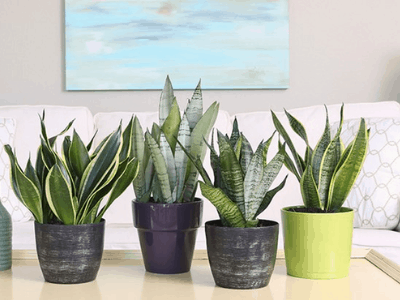
Air-conditioned rooms have a cool temperature, cold drafts, and dry air, which harms the growth of your indoor plants. In addition, not all indoor plants can survive in such living conditioned.
Richa, author from simplifyplants.com
Here’s the main thing!
Here’s The List Of Plants For Air Conditioned Rooms!
- Air Plants
- Snake Plants
- Monstera Plants
- Photos
- Peace Lily
- ZZ Plant
- Parlor Palm
- Boston Fern
- Prickly Pear
- Spider Plant
How To Take Care of Them?
Air Plants

Tillandsias, also known as air plants are becoming…
…more and more popular among home and office owners.
They are low maintenance and offer an array of colors and forms.
Depending on the climate, air plants can survive in a wide range of conditions.
Mounted on the wall by planting on a board and kept in rooms with air conditioning…
…they can survive in a wide range of conditions.
Nevertheless, they should not be mounted….
….on the opposite wall from the AC to avoid direct drafts.
Sunlight
The Tillandsia, though they prefer indirect light…
…can survive darkness for a few days too.
They need to be watered directly in the morning…
…or evening sunlight to stay hydrated.
Watering
Submerge tillandsias in water and soak for half an hour.
After they dry, hang them back to their display…
…and water them weekly in summer.
Shake off excess water from the tillandsia and let them dry…
…upside down or in good air circulation until fully dry.
Fertilizer
Tillandsias do not necessarily require fertilizer.
However, feeding can promote their growth and good health.
Once a month in the growing season, spray on the plant…
…with fertilizer or food specifically designed…
…for air plants or bromeliads.
These are our top picks of plant food that are…
…specifically for bromeliads on Amazon.
You can start by adding water to a spray bottle…
…adding fertilizer, and spraying on the plant.
General Care
The temperature range for Tillandsia is between 50°F and 90°F.
They need average humidity and good air circulation.
Next…
Snake Plant: Easy-To-Grow Plants
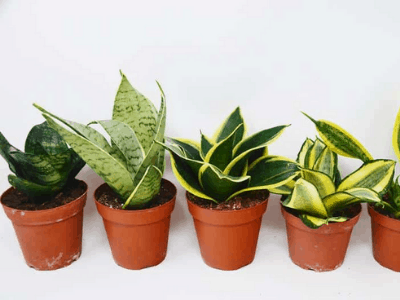
Snake plants are popular houseplants that are easy to grow…
…drought-tolerant and can survive…
…in a variety of environments.
A snake plant is a hardy plant suitable for air-conditioned rooms…
…and they have the added benefit of cleaning the air…
…and making it breathable so the air is cleaner for you…
…as well as fresher for your nose.
Sunlight
Snake plants prefer bright, filtered light but they can also…
…tolerate low light and shady corners.
They can also grow in indirect light….
…You can also use artificial light sources…
…if you are lacking the necessary amount of sunlight.
Watering
If the soil feels moist or is stuck to the skewer then wait…
….until the soil is dry before watering.
Snake plants don’t like the soil to sit in water.
You can test the soil by digging a finger or skewer two…
…to four inches deep in the soil.
Fertilizer
In the growing season, feed snake plants once every month…
…with a balanced houseplant food.
Make sure the fertilizer is diluted to half strength…
…and avoid feeding during winter and fall.
General Care
The snake plant should be kept at a temperature of…
….at least 50°F during the cooler months.
Keep them away from draughts during the winter.
Snake plants are easy to care for, but growing them…
…from the seeds can be complicated.
If you’re looking for a trusted store that can ship live snake plants safely to your house, we’ve tried many stores on Amazon. This is the best store according to our experience.
Prices pulled from the Amazon Product Advertising API on:
Product prices and availability are accurate as of the date/time indicated and are subject to change. Any price and availability information displayed on [relevant Amazon Site(s), as applicable] at the time of purchase will apply to the purchase of this product.
Keep going…
Monstera Plant
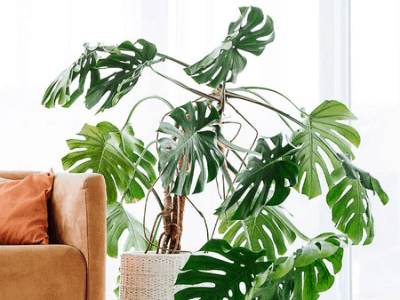
These plants are easy to grow, versatile, and have beautiful foliage.
They are also known as swiss cheese plants because of their holes in the leaves.
Vining plants, trail over or along with the sticks.
They are adaptable making them a great choice for air-conditioned rooms.
They just require the least maintenance to thrive.
Sunlight
The monstersa can tolerate some direct light but…
…excessive direct light will burn the leaves.
You can provide your monsteras with bright indirect light or low light…
…as well as some hours of low direct light.
Watering
In the summer, water monstera once a week…
…to prevent soil from becoming soggy.
Overwatering could stunt their growth…
…while watering less during the cool months could prevent root rot.
Fertilizer
Feed monsteras one ounce of balanced houseplant food…
…once a month during the growing season by diluting it…
…to half the recommended strength.
If you’re looking for one, this one is a great example.
General Care
Make sure your monsters are well-hydrated…
…by maintaining a high humidity level and misting them occasionally.
Monsteras prefer temperatures between 50°F-80°F…
…but should not be exposed to cold drafts or direct air from heaters.
Keep reading…
Pothos

Tropical Pothos come in patterns and colors that complement…
…both the decor and tastes of their owners.
It is a relatively flexible and forgiving houseplant…
…with shiny heart-shaped leaves.
Pothos removes toxins from the air and can be…
…maintained almost anywhere, including air-conditioned rooms.
Sunlight
It prefers indirect, filtered light although it will tolerate…
…some low to moderate light too.
Direct light tends to burn their leaves.
Watering
If possible, water the pothos once a week….
…allowing the soil to dry completely between waterings.
Drain excess water after waterings and…
…reduce watering frequency during dormancy.
Fertilizer
Plants of this type do not require much feeding…
…so extend the interval between feedings to 2-3 months.
Apply a balanced fertilizer every 2-3 months and…
…avoid feeding in the dormant period.
General Care
Make sure that the temperature around your pothos is above 50°F.
They prefer high humidity, and occasional misting will help.
Go on…
Peace Lily
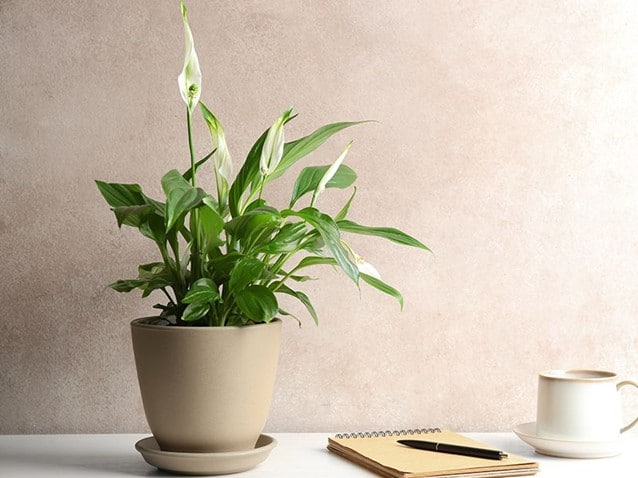
The peace lily grows to a height of 16 inches high indoors…
…and produces white flowers in the summer.
It is a tropical evergreen plant that is relatively easy to grow.
If your home is air-conditioned, peace lilies will grow happily indoors…
…provided they are not exposed…
….to direct air from your air conditioner.
Sunlight
You should place peace lilies in brightly lit rooms which should be indirect.
A lot of direct light harms them, and morning light is good.
Watering
In summer, as the sunlight is intense…
…water the peace lily every few days, keeping the soil…
…evenly moist between waterings.
Avoid overwatering and let the excess water drain completely.
Fertilizer
Do not fertilize peace lily during dormancy.
Fertilize peace lily every two months with balanced houseplant food.
Dilute the strength by half.
General Care
Misting allows for the creation of humidity.
Peace lilies thrive in temperatures above 60°F.
They appreciate being away from cold drafts and direct sunlight.
Don’t waste your time growing peace lilies from scratch.
This store takes great care of their lilies and can ship them to you.
Their packaging is very safe and the quality of the plant won’t be disappointing.
Check them out!
Next up…
ZZ Plant: Drought-Tolerant Plants For Air Conditioned Room
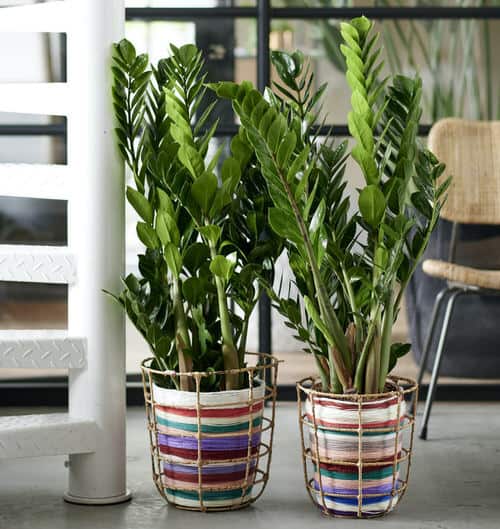
ZZ plants have thick oval-shaped deep green leaves…
…that are drought-tolerant and adaptable…
….to a variety of environments.
They are attractive, low-maintenance and a wonderful addition to any room.
A healthy ZZ plant can also be grown by most inexperienced gardeners.
They can thrive in a climate between 70°F and 85°F.
This is a recommended ZZ plant that you can choose on Amazon, our top picked item will land to your hands with a perfect packaging!
Prices pulled from the Amazon Product Advertising API on:
Product prices and availability are accurate as of the date/time indicated and are subject to change. Any price and availability information displayed on [relevant Amazon Site(s), as applicable] at the time of purchase will apply to the purchase of this product.
Sunlight
The ZZ plant prefers bright indirect light whether natural or artificial.
Its leaves can burn in too much direct light.
However, the plant is tolerant of all lighting.
Watering
You should water the ZZ plant once a month.
They are drought-tolerant, so let the soil completely dry between waterings.
Do not keep the soil soggy.
Fertilizer
The plants need little fertilizer and can thrive without it too.
Fertilize them with a balanced house plant food by lowering the strength to half.
Do not fertilize them during the dormant period.
General Care
Household humidity and temperature are best suited for ZZ plants.
Please do not keep them below 45°F and avoid cold drafts.
Not even close, keep going!
Parlor Palm: Bamboo-Look Alike Plants For Air Conditioned Room
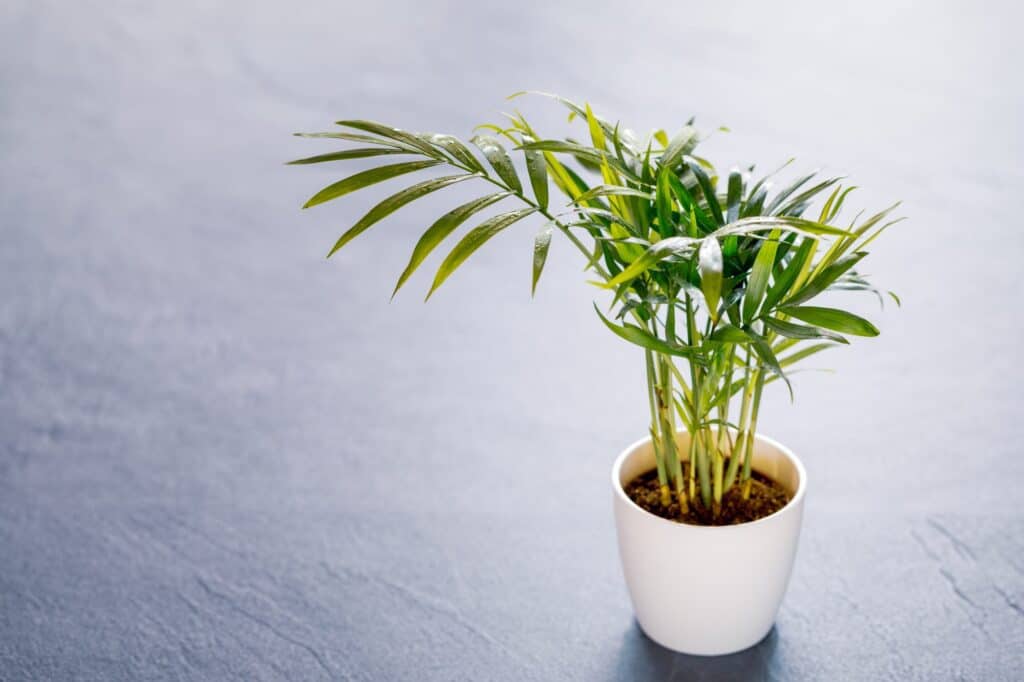
Because of their bamboo-like stalks…
….Parlor palms look similar to bamboo plants.
They’re classic plants low maintenance, and grow up to six feet tall.
These plants make excellent choices for air-conditioned rooms….
….that require little maintenance.
It’s unique, one of a kind, and definitely will match your room perfectly!
Prices pulled from the Amazon Product Advertising API on:
Product prices and availability are accurate as of the date/time indicated and are subject to change. Any price and availability information displayed on [relevant Amazon Site(s), as applicable] at the time of purchase will apply to the purchase of this product.
Sunlight
The parlour palm thrives in moderate to bright indirect light.
Provide ample light, while avoiding direct sunlight, and it will thrive.
Watering
Water parlor palms once a week.
The rule is to let the soil dry completely before watering again.
They do not like drowning soil and can survive with some water neglect, too.
Fertilizer
Parlor palms require only a weak houseplant fertilizer…
…every two weeks during the growing season…
….and should not be given food during the dormant period.
General Care
Ideally, Parlor Palms require regular to high humidity…
…and average temperatures.
They dislike being exposed to cold or hot drafts.
Next on…
Boston Fern: Diamond-Shaped Plants For Air Conditioned Room

A Boston fern is a houseplant with a unique formation.
It grows from a middle rhizome with diamond-shaped fronds that narrow at the tip.
Most growers find it hard to grow them and once you know how you’ll love them.
They’re one houseplant that thrives in a cool environment…
…as long as you take good care of it.
Other than costa farm that packed plants in a good shape, nearly farm is also one of our top picked store to buy plants online! Their picked plants are incredibly lovely!
Prices pulled from the Amazon Product Advertising API on:
Product prices and availability are accurate as of the date/time indicated and are subject to change. Any price and availability information displayed on [relevant Amazon Site(s), as applicable] at the time of purchase will apply to the purchase of this product.
Sunlight
Insufficient light can cause Boston fern leaves to yellow and wilt.
Boston fern prefers indirect light, preferably a north-facing window.
Watering
The Boston fern should be watered once a week on a routine basis.
Just keep the soil moist without leaving it soggy, so your roots won’t rot.
Fertilizer
You should also feed Boston ferns once a month in the growing season…
….with a seaweed tonic so that they receive the nutrients they need and remain beautiful.
General Care
Boston ferns prefer high humidity so mist them regularly to keep humidity high.
You can use a pebble tray or humidifier to maintain the humidity levels around them.
Keep reading…
Prickly Pear: Sturdy Plants For Air Conditioned Room
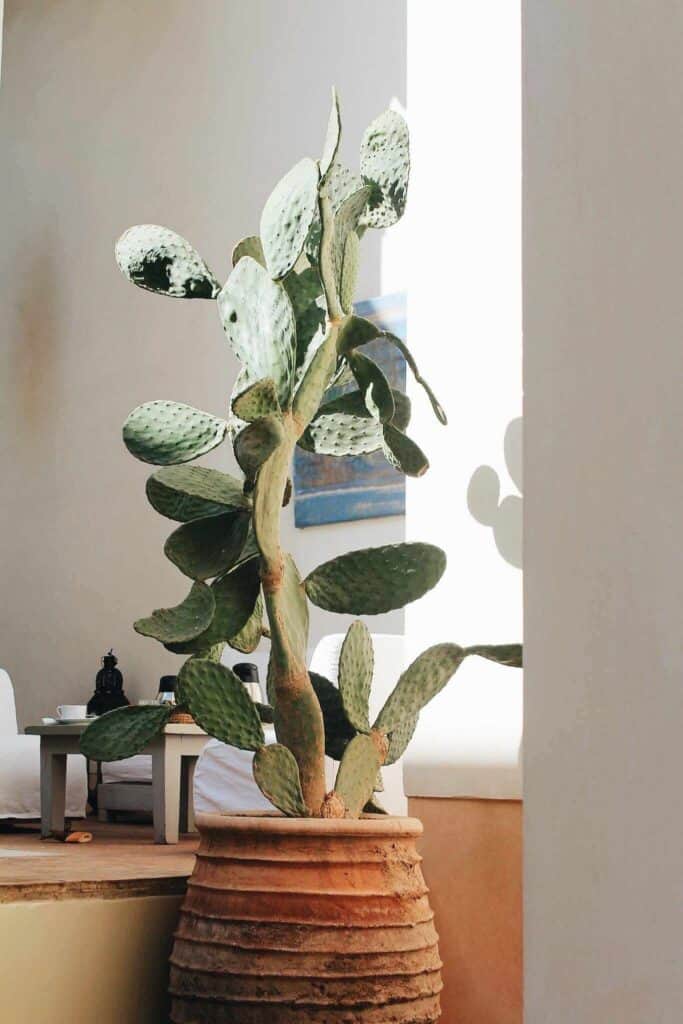
Despite its sturdy and easy-to-care-for nature,
Prickly Pears thrive in almost any climate and produce colorful flowers.
Their size can reach one foot high and one foot wide,
and they can thrive in an air-conditioned room despite varying temperatures.
This thornless prickly pear is easier to packed and we specially picked this item since it’s a lot safer for you to pick from the packaging if it’s thornless!
Prices pulled from the Amazon Product Advertising API on:
Product prices and availability are accurate as of the date/time indicated and are subject to change. Any price and availability information displayed on [relevant Amazon Site(s), as applicable] at the time of purchase will apply to the purchase of this product.
Sunlight
Prickly pear plants prefer at least 6-8 hours of direct sun.
In hotter climates, partial shade is okay but full sunlight…
…is needed for full growth and bloom.
Watering
In summer, water prickly pear once every two months…
…and in winter once every month.
They tolerate drought but prefer moist soil.
Fertilizer
In the growing season, fertilize prickly pear plants…
…once every month with balanced houseplant food.
Fertilizing them during a dormant period is not necessary.
General Care
Prickly pear trees should be pruned to maintain their size and shape.
They prefer acidic and neutral soil mixes.
They prefer warm, dry weather and can survive temperatures as low as 14°F.
Last but not least!
Spider Plant: Unique Plants For Air Conditioned Room
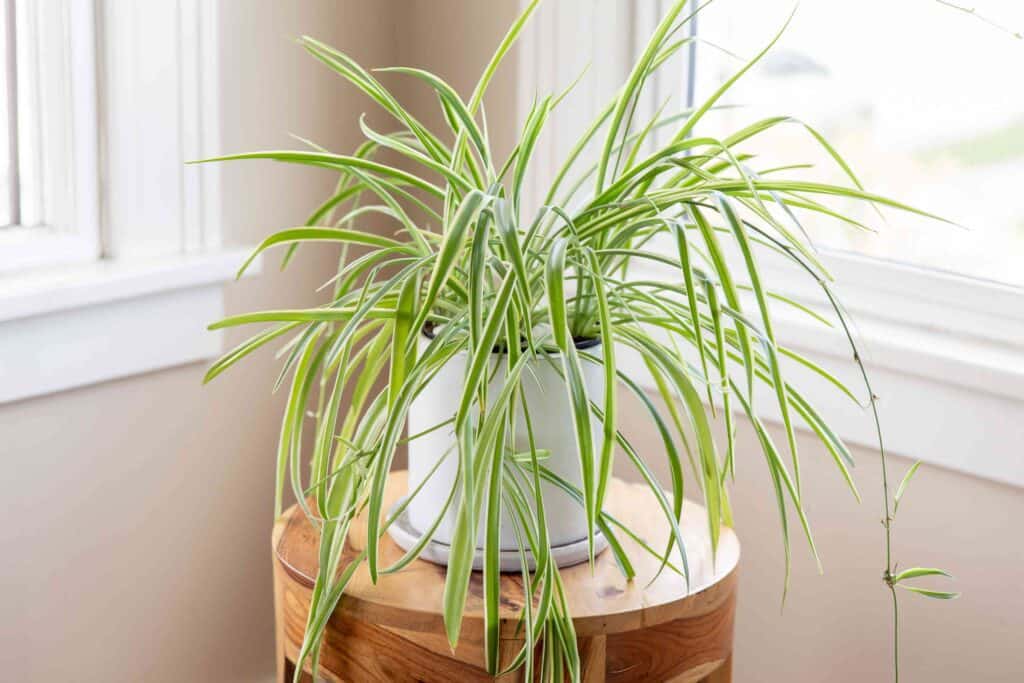
Spider plants have curving green or green and white striped…
…leaves that can grow up to 1.5 feet long.
They are easy to maintain and low maintenance.
These plants grow slowly and are forgiving so…
…they can thrive even in a home equipped…
…with an air conditioning system.
Other than it’s trive on air conditioning system, this one we choose for you is reverse variegated, it’s unique and beautiful!
Prices pulled from the Amazon Product Advertising API on:
Product prices and availability are accurate as of the date/time indicated and are subject to change. Any price and availability information displayed on [relevant Amazon Site(s), as applicable] at the time of purchase will apply to the purchase of this product.
Sunlight
Light shade is needed for spider plants but bright light helps them grow healthy.
Direct sunlight, on the other hand can damage their leaves…
…and cause them to grow poorly.
Watering
If you water spider plants be sure to keep the soil moist but not soaking.
You can water them once a week but making sure the soil is…
…moist will save them from water issues.
You can use filtered or rainwater.
Fertilizer
In the growing season, you should feed your spider plant…
…a balanced houseplant food once a month.
Balanced plant food that is diluted should be used.
General Care
The plants prefer warm, moist conditions.
They should be protected from cold and direct sunlight.
Temperatures below 50°F are harmful to them and may stunt their growth.
Things To Consider Before Buying Plants For Air Conditioned Room
There are numerous reasons to incorporate greenery into the interior of your home.
Even during the spring and summer months when there is plenty of it outside.
Plants for air conditioned room can help clean the air…
…and add to the aesthetics of your home.
According to some studies, they can even…
…boost your creativity and productivity!
However, as many of you may have discovered…
…some people do not fare well in an air-conditioned environment.
Some plants will not thrive in air-conditioned environments…
…because they are simply not designed for it…
….and there is little you can do about it unless you stop…
…using your A/C which very few people are willing to do.
However, there are a few indoor plants that…
…with proper care, can thrive in a temperature…
….and humidity controlled environment.
So, if you want to add some natural color…
…to your home this year here are some guide on…
….choosing the best plants for air conditioned room.
Easy To Care and Low Maintenance Is Key
When it comes to indoor plants most homeowners…
…prefer low-maintenance plants…
…that are simple to care for.
All of the plants we’ll be discussing today fall into one of these two categories.
The best way to care for indoor plants that work with AC is to buy potting soil…
….that is appropriate for your indoor temperature.
Each of these plants should be watered only…
…when the soil is completely dry, perhaps once a week or so.
When you aren’t watering the plants mist the leaves every day.
Indoor plants store moisture in their leaves which AC removes.
By misting your plants every day with a simple spray bottle…
…you can ensure that your plants are storing…
…the moisture they require without over-saturating the roots.
Plant Location Is Important
Plants, like people, have preferred locations in the home.
When it comes to light, nearly all plants have different requirements.
Some plants thrive in low-light environments…
…while others prefer to be near a sunny window.
It all depends on the type of plant.
If you’re not sure where to put your plants keep an eye on them for a few weeks.
Are the leaves yellowing or withering?
They’re probably too close to an AC vent or in the wrong kind of light.
Simply move them around and see where they prefer to live.
Take Note of The Humidity
It’s no secret that your air conditioner dries out your home.
While this may be the end of many plants with the…
…above-mentioned care and maintenance…
…your plants will thrive in an AC-rich environment.
Despite this, if you notice your humidity levels rising…
…you may have problems with both the plants and the AC.
So you need to pay attention more to maintenance.
Sum Up
We can conclude that repotting the indoor plant after purchase…
….is only possible after analyzing the current state of the plant.
In certain circumstances repotting your plants might do more harm than good.
In others, however, you may need to do it.
The best way to decide whether to repot your plants…
…would be to evaluate the situation first.
If needed, you can always keep the plants in the same pot.
Conclusion
Last thing for sure…..
This plant needs to care for carefully, remember all plants need “love” too.
Alright, that’s all for today!
Do you have any questions about all of this?
Or do you want to add more varieties of plants for air conditioned room?
Let me know your recommendation from the comment below.
I hope you can now take care of your plant and it’s growing big and healthy!
Thanks for reading this article!…
…Bye!
Frequently Asked Questions Around Best Plants for Air Conditioned Room
If you’re like most people, you love air conditioning in your home.
But air conditioning can also cause problems – it can make the air…
…humidity levels high, which can lead to mold and other indoor air problems.
To help protect your air conditioning system and your indoor environment…
…you should plant plants in your home that are good at dealing with high humidity…
…levels.
How can I make sure that the plants in my air-conditioned room are healthy and effective?
Plants can be a healthy and effective way to address indoor air quality concerns.
A study published in the “Journal of Environmental Quality” in 2012 found…
…that plants can improve indoor air quality by absorbing pollutants and releasing oxygen.
The study also found that plant species and plant size influenced indoor air quality.
What is the best way to store plants for use in an air conditioned room?
The best way to store plants for use in an air-conditioned room is to keep them in a humidity chamber.
Which plant would grow well in an air-conditioned room?
The best plant for an air-conditioned room is ferns.

















































